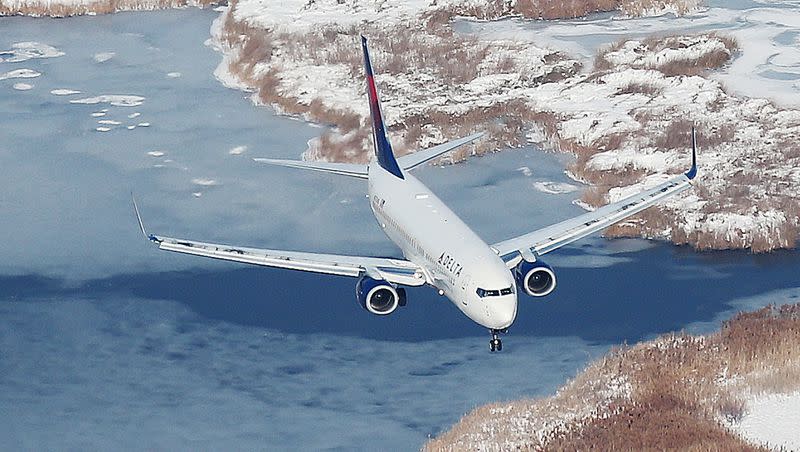Opinion: Utahns deserve more affordable access to Washington, D.C.

Serving the 4th District of Utah is one of my greatest honors and achievements. When I’m in Washington, D.C., nothing makes me happier than connecting with Utahns on Capitol Hill. It’s a pleasure to meet with schoolchildren, educators, business leaders and Utahns from all walks of life, and my door is always open for those who want to visit.
As Utah has grown, both economically and in population, so too has the demand for better direct access to Washington, D.C. More residents seek to visit the nation’s capital for pleasure, while our booming business sector requires more frequent engagement with federal policymakers. But traveling to the capital region from Utah is not easy, because for nearly 60 years Ronald Reagan Washington National Airport, also known as DCA, has been governed by the federal perimeter rule — a little known Federal Aviation Administration regulation that has a profound impact on the way we travel.
With few exceptions, the perimeter rule restricts the number of flights to and from locations beyond 1,250-miles of DCA. As a result, Western states such as Utah have very limited direct access to the Washington, D.C., region, and consumers are paying the price with higher ticket prices and longer travel times.
Congress enacted the perimeter rule in 1966, but as air travel has evolved, the policy hasn’t — and the failure to update this decadeslong regulation has resulted in unintended consequences for our beyond-perimeter communities. Ninety-five percent of beyond-perimeter markets are currently underserved. Demand has fallen far behind supply, making Washington, D.C., the most expensive domestic market in the U.S. There are only 20 daily roundtrip flights to 10 beyond-perimeter destinations, which is less than 6% of DCA’s 437 daily departures. Salt Lake City International Airport, for example, has only one direct flight to DCA per day.
Because DCA is owned by the federal government, adding new flights must be approved by Congress. I’m proud to be the first Utahn to serve our state on the House Transportation and Infrastructure Committee in over 20 years, where Congressman Hank Johnson, D-Ga., and I have taken the first step to modernize the perimeter rule by introducing The Direct Capital Access Act — a bipartisan bill to add 28 in- and beyond-perimeter flights at DCA as part of the 2023 Federal Aviation Administration Reauthorization bill. These additions, which would be divided equally among the airlines that serve DCA, will help make traveling to Washington, D.C., more affordable by giving consumers more choice in how and when they fly.
Related
A pro-free market, pro-consumer policy seems like an easy choice to support, but instead of supporting consumers, opponents are supporting the status quo. They argue that adding more flights will lead to more noise and congestion around DCA, and they assert that DCA doesn’t have the capacity for more flights to begin with, but the facts say otherwise.
A new study by one of the country’s top management consulting firms found that DCA is an underutilized airport and has the capacity to add dozens more roundtrip flights per day. Even if all 28 new flights were authorized and allocated to beyond-perimeter locations, it would still amount to less than 10% of DCA’s total daily flights.
The study also highlights the fact that today’s aircraft are and will continue to be quieter, faster and more efficient. Adding more flights will help consumers save money on airfare through boosted competition, while also saving them time through fewer connections.
Federal investments such as “Project Journey,” DCA’s $1 billion expansion, has enabled it to serve thousands more daily passengers. The Metropolitan Washington Airports Authority has said repeatedly that Project Journey’s infrastructure improvements will “ease congestion” and “enhance the customer experience.”
Alternatively, Washington, D.C.-Maryland-Virginia residents who want to visit Utah would also benefit from more direct flights. Utah’s beautiful state parks and world-class skiing draw millions of tourists from all over the country. Improving direct access from DCA to Utah would help boost tourism and spur economic growth.
Costly airfare or unnecessary connections should never be a barrier for Utahns to visit Washington, D.C. The FAA Reauthorization bill comes to a vote every five years, and this year we have the opportunity to make traveling to the national capital region affordable — not just for Utahns, but for everyone in our Western states. I urge my colleagues in the U.S. House of Representatives to join me and Congressman Johnson in supporting The DCA Act and making Washington, D.C., accessible for all.
Burgess Owens represents Utah’s 4th Congressional District.

